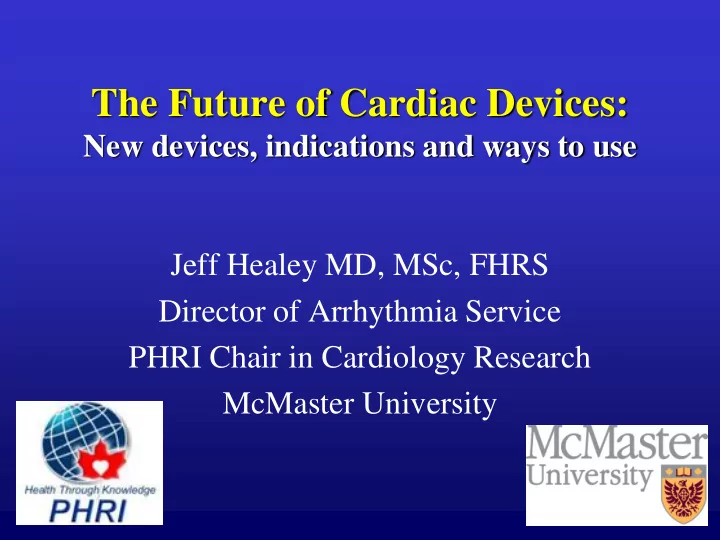

The Future of Cardiac Devices: New devices, indications and ways to use Jeff Healey MD, MSc, FHRS Director of Arrhythmia Service PHRI Chair in Cardiology Research McMaster University
Evolution of Cardiac Device Therapy • Better cardiac implantable electrical devices – Smaller devices, longer battery life – MRI-conditional devices, wireless, remote-monitoring – Leadless pacemakers and defibrillators, injectable ILR • Better ways to minimize CIED morbidity – Better surveillance of devices and leads – Studies to reduce infection, bleeding, lead failure • Novel applications of CIED technology – Detection of atrial fibrillation – Advance warning of heart failure
ICD: Mirowski M. 1978 Circulation 58(1):90-4 209 cc 120 cc 80 cc 80 cc 72 cc 54 cc 62 cc 49 cc 39.5 cc 38 cc 39.5 cc 39.5 cc 36 cc
MRI-Conditional Pacemakers/ICDs • All ILR, Most PM, many ICD • Some cautions remain • Coordination with PM/ICD clinic • Cost issues MDT Sure-Scan pacemaker Heart Rhythm 2011
Surveillance of Devices and Leads • Most centres with electronic databases • CHRS Device committee, volunteer group • Provide clinical guidance to hospitals • World leaders in publications on – Device reliability (Marquis, Riata, Fidelis, etc.) – Implant-related device complications – Randomized trials to reduce device morbidity • (PADIT, SIMPLE, BRUISE-CONTROL, etc.)
The Lead is the Weakest Part of the ICD System
Leadless Pacing Medtronic Micra; NEJM 2015
Leadless Pacing St. Jude Nanostim
A new category of implantable defibrillators Transvenous (TV) ICDs The S-ICD System • • Provides effective defibrillation for Provides effective defibrillation for ventricular tachyarrhythmias ventricular tachyarrhythmias • • Provides Brady pacing No risk of vascular injury • • Provides ATP for patients with incessant Low risk of systemic infection monomorphic VT • Preserves venous access • Provides atrial diagnostics • Avoids risks associated w/ endovascular • Familiar implant technique lead extraction • Fluoroscopy not required 11
S-ICD in clinical practice
S-ICD Pooled Results Demographics 43% of the study population were Primary Prevention Patients with an EF 35% Demographic N (%) Age (years) 50.3 ± 16.9 Male (n, %) 636 (72.5) Ischemic 330 (37.8%) Genetic 58 (6.7%) Idiopathic VF 40 (4.6%) Channelopathies 90 (10.3%) NYHA Classification II-IV 327 (37.5%) Atrial Fibrillation 143 (16.4%) Previous Defibrillator 120 (13.7%)
S-ICD Pooled Results S-ICD and TV-ICD Spontaneous Conversion Efficacy When evaluating TV-ICD studies 1-4 , S-ICD was as effective as TV-ICD in treating spontaneous arrhythmias Spontaneous Shock Efficacy First Shock Final Shock in episode S-ICD Pooled Data* 90.1% 98.2% ALTITUDE First Shock Study 1 90.3% 99.8% SCD-HeFT 2 83% PainFree Rx II 2 87% MADIT-CRT 3 89.8% LESS Study 4 97.3% * Excluded VT/VF Storm events Of two “unconverted” episodes S-ICD Pooled Data • One spontaneously terminated after the 5th shock 100% Clinical conversion to normal • In the other episode, the device prematurely declared the episode ended. A new episode sinus rhythm was immediately reinitiated and the VF was successfully terminated with one shock 1 Cha YM et al. Heart Rhythm 2013;10:702 – 708. 2 Swerdlow CD et al. PACE 2007; 30:675 – 700. 3 Kutyifa V, et al. J Cardiovasc Electrophysiol 2013;24:1246-52. 4 Gold MR et al. Circulation 2002;105:2043-2048.
Objectives: ATLAS Primary Objective: To compare the rate of perioperative complications, measured at 6- months following implant, between patients receiving an S-ICD compared to those receiving a TV-ICD. Secondary Objectives : 1. To determine if the S-ICD is associated with fewer long-term device-related complications. 2. To determine if the S-ICD has a similar effectiveness for the treatment of ventricular arrhythmias and is associated with a similar risk of failed appropriate ICD shock and/or arrhythmic death 15
Implantable Monitoring Smaller devices Improved diagnostics Outpatient implant Wireless telemetry Increased cost
Sub-Clinical AF Detected by Pacemakers 1.Mostly asymptomatic 2.Relatively short episodes detected only with long-term, continuous monitoring
ASSERT-II: Incidence of SCAF Rate per year (95% CI) 34.4% (27.7% – 42.3%) 21.8% (16.7% – 27.8%) 7.1% (4.5% – 10.6%) 2.7% (1.2% – 5.0%)
Conclusions Cardiac implantable electrical devices – Getting smaller – Wireless telemetry, remote monitoring – MRI conditional – Leadless devices Many advances to reduce device morbidity – Prevent ICD shocks – Prevent unnecessary pacing – Prevent infection and hematoma
Recommend
More recommend